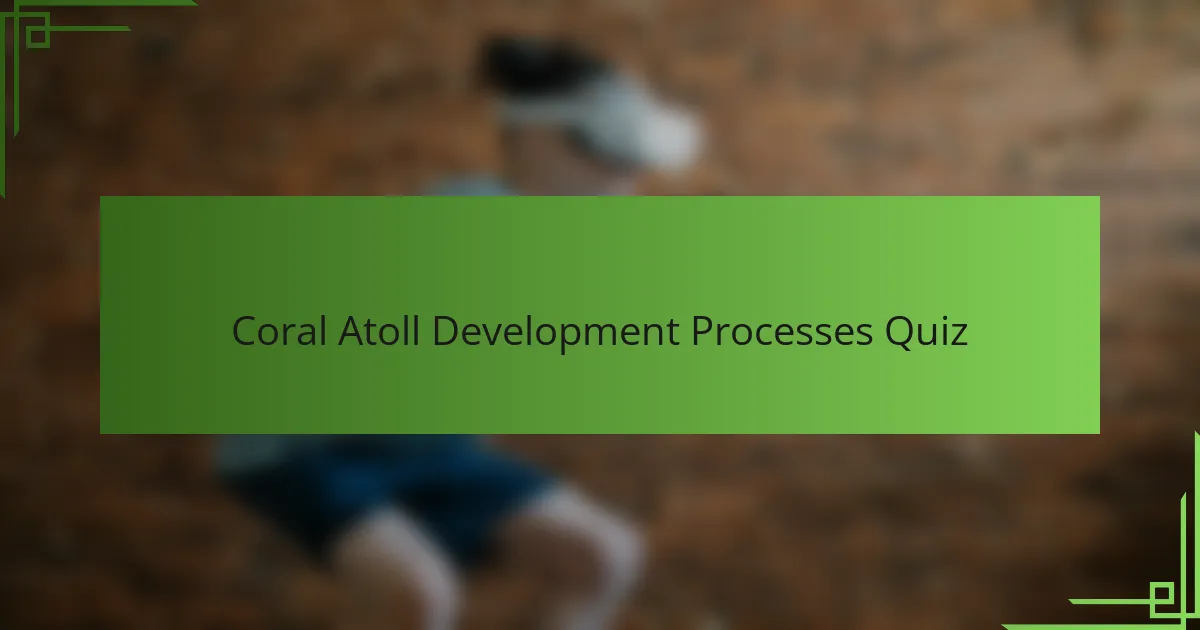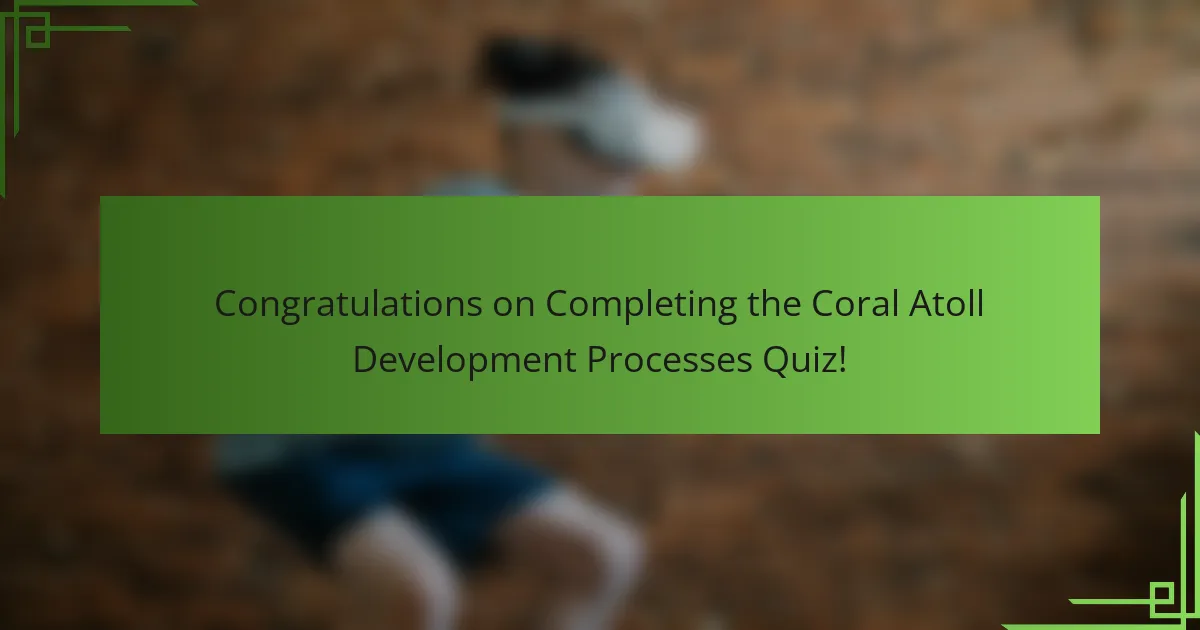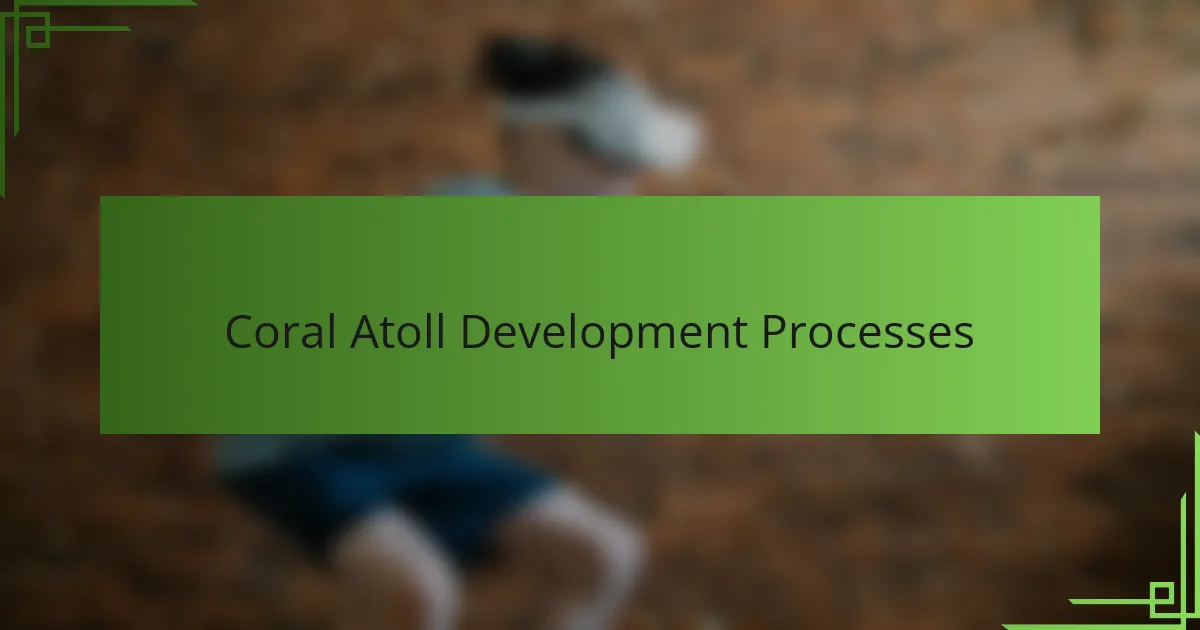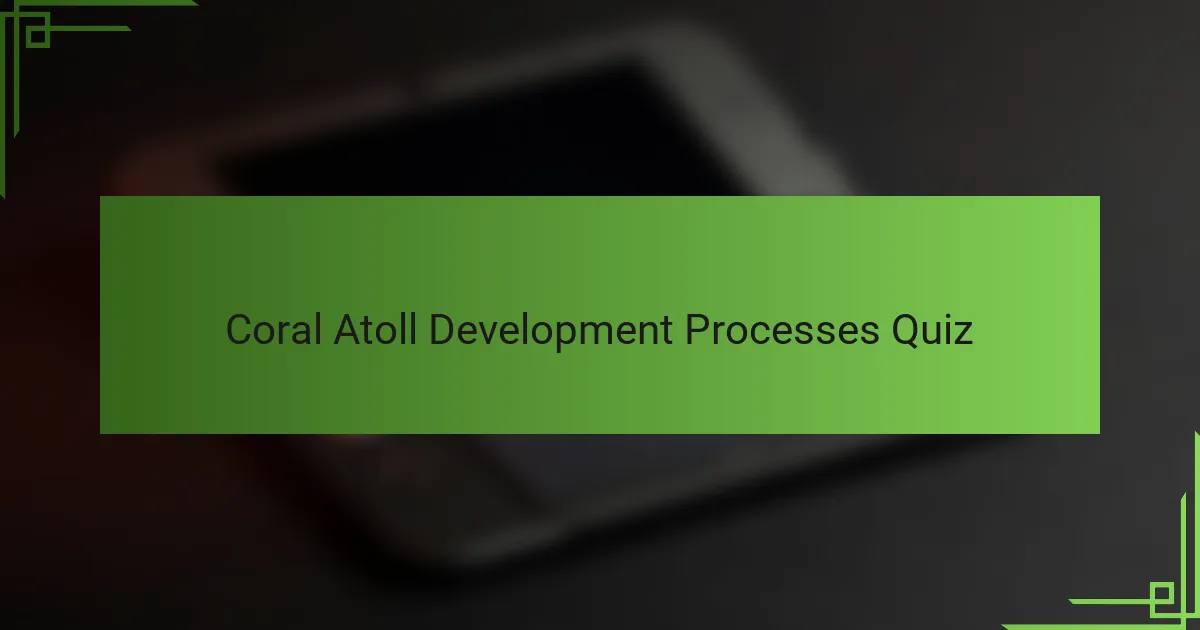
Coral Atoll Development Processes Quiz
1. What is the primary geological process responsible for the formation of coral atolls, as first described by Charles Darwin?
- Erosion of limestone platforms exposing coral reefs
- Subsidence of volcanic islands leading to coral growth upward
- Tectonic uplift exposing ancient coral reefs to form atolls
- Sea-level rise causing coral to spread laterally on shallow shelves
2. How does the gradual subsidence of volcanic islands contribute to the development of coral atolls in the Pacific Ocean?
- The sinking of volcanic islands allows coral reefs to grow upward and form ring-shaped atolls encircling lagoons where the island once was.
- Coral atolls form from coral fragments accumulating on stable volcanic islands without any subsidence.
- Rising volcanic islands create new land for corals to colonize, eventually forming atolls as the islands stabilize.
- Volcanic island erosion deposits sediments that spread coral polyps over a broad area, developing atolls on flat seafloors.
3. Which marine organism is essential for building the calcium carbonate structures characteristic of coral atolls?
- Sea urchins
- Hermatypic corals
- Red algae
- Foraminifera
4. In the context of coral atoll development, what role does coral reef growth play in maintaining atoll elevation relative to sea level?
- Coral reef growth accumulates calcium carbonate, building up the reef structure and keeping the atoll surface elevated relative to rising sea levels.
- Coral reef growth erodes volcanic rock foundations, causing the atoll to sink but maintaining its surface elevation.
- Coral reef growth decreases water temperature, reducing thermal expansion and indirectly maintaining atoll elevation.
- Coral reef growth stabilizes atoll sand deposits by trapping sediments, which alone raises the atoll relative to sea level.
5. How does the lagoon formation within a coral atoll come about during the atoll development process?
- The lagoon develops from tidal erosion cutting into the island, trapping seawater inside.
- The lagoon forms as the volcanic island subsides and coral growth continues upward around the edges, leaving a central water-filled basin.
- The lagoon forms when coral actively excavates and lowers the central island, creating a depression.
- The lagoon results from freshwater accumulation over time as rainfall collects in a volcanic crater surrounded by coral.
6. What is the significance of the Great Barrier Reef in Australia for understanding coral atoll and reef formation processes?
- It is the only coral reef formed entirely by volcanic activity distinct from atoll formation.
- It is primarily important because it is the oldest coral reef, showing ancient atoll formations.
- The reef`s significance is mainly its isolation from external ocean currents affecting coral growth.
- The Great Barrier Reef demonstrates the stages of coral atoll development along a continental shelf affected by sea level changes.
7. Which island chain in the Indian Ocean is considered a classic example of coral atoll development?
- Maldives
- Andaman Islands
- Seychelles
- Comoros
8. How does wave action influence sediment deposition on the reef flat of a developing coral atoll?
- Wave action redistributes sediment across the reef flat, sorting particles by size and promoting the accumulation of finer materials in sheltered areas.
- Wave action causes sediment to settle only near the reef edge, leaving the interior reef flat largely sediment-free.
- Wave action primarily deposits coarse sediments evenly across the reef flat, preventing sediment sorting.
- Wave action reduces sediment deposition by breaking down particles into finer dust that is easily washed away.
9. What geological feature typically marks the initial stage in the formation of a coral atoll?
- Sandbar formation
- Seamount emergence
- Barrier reef development
- Volcanic island
10. In coral atoll development, how does biological weathering by marine organisms affect the atoll`s surface morphology?
- It deposits additional calcium carbonate, smoothing the atoll`s surface over time.
- It primarily causes vertical uplift by stimulating coral growth.
- It gradually erodes the limestone substrate, creating pits and channels that increase surface complexity.
- It compacts coral debris into solid rock, flattening the atoll surface.
11. How do the Maldives exemplify the stages of coral atoll formation and development?
- The Maldives` coral structures grew atop a stable, non-subsiding continental shelf rather than a sinking volcanic base.
- The Maldives illustrate coral atoll formation beginning with volcanic island subsidence, followed by coral reef growth and lagoon development, showing classic Darwinian stages of sinking and coral accumulation.
- The Maldives formed primarily through tectonic uplift of coral beds without volcanic influence or subsidence.
- The atolls of the Maldives originated from ancient river deltas that were later colonized by corals.
12. Which oceanic region contains the majority of the world`s coral atolls due to its tectonic and volcanic activity?
- The Atlantic Ocean
- The Pacific Ocean
- The Indian Ocean
- The Arctic Ocean
13. How does the age of volcanic islands influence the structure and complexity of their associated coral atolls?
- Older volcanic islands tend to have more developed and complex coral atolls due to longer periods of subsidence and reef growth.
- Younger volcanic islands typically have more complex coral atolls because rapid volcanic activity promotes coral diversity.
- Coral atolls form only on ancient volcanic islands that have completely eroded away, regardless of their age.
- The age of volcanic islands does not influence coral atoll structure, as atoll complexity depends solely on ocean currents.
14. What effect does rising sea level have on the sustainability and morphological changes in coral atoll structures?
- Rising sea levels cause coral atolls to sink uniformly, reducing their area but maintaining their morphological features.
- Rising sea levels primarily enhance coral growth, allowing atolls to expand and stabilize despite increased water depth.
- Rising sea levels have little effect on coral atolls because coral growth directly compensates for any water level increases.
- Rising sea levels increase erosion and flooding on coral atolls, threatening their stability and causing significant morphological changes.
15. How does the presence of fringing reefs around volcanic islands transition into barrier reefs before becoming atolls?
- The volcanic island erupts repeatedly, causing coral reefs to grow vertically into barrier reefs before the island erodes into an atoll.
- As the volcanic island slowly subsides, coral growth keeps pace by extending outward to form a barrier reef separated by a lagoon, which eventually encloses a central island to become an atoll.
- Fringing reefs detach completely from the volcanic island due to tectonic shifts, creating a barrier reef that later accumulates sediment to form an atoll.
- Barrier reefs originate from separate coral colonies that form independently offshore, which then surround the volcanic island as it emerges to form an atoll.

Congratulations on Completing the Coral Atoll Development Processes Quiz!
Well done on finishing the quiz about coral atoll development. You have engaged with important concepts that explain how these unique landforms evolve over time. From understanding the role of coral growth to the impact of sea level changes, this quiz has helped clarify the natural processes that shape atolls.
Through these questions, you may have strengthened your knowledge of geological and biological interactions in marine environments. The quiz encourages thinking about how delicate ecosystems like coral reefs support broader geographical phenomena. This foundation is essential for anyone interested in physical geography or environmental science.
If you found this quiz informative, we invite you to explore our next section on this page. It offers deeper insights and detailed information on coral atoll formation and their significance in Earth’s geography. Continuing your learning journey here will help you better appreciate these fascinating coastal formations.

Coral Atoll Development Processes
Definition and Formation of Coral Atolls
Coral atolls are ring-shaped coral reefs that encircle a lagoon either partially or completely. They form in tropical ocean waters, primarily through the growth of coral organisms, mainly from the genus Acropora and Porites. The initial stage involves the development of fringing reefs around volcanic islands. Over time, the volcanic island subsides due to tectonic processes while the coral continues to grow upward and outward. This gradual process results in the formation of a barrier reef and finally a coral atoll surrounding a central lagoon.
Role of Volcanic Island Subsidence in Atoll Development
The subsidence of volcanic islands is a critical process in coral atoll formation. A volcanic island, such as those in the Pacific Ocean near Tonga or the Hawaiian-Emperor seamount chain, gradually sinks due to the cooling and contracting of the underlying oceanic crust. As the island descends, living coral grows vertically on the periphery, maintaining the reef structure close to the ocean surface. This sustained coral growth amid island subsidence creates the characteristic ring-like structure of an atoll.
Ecological and Geological Factors Influencing Coral Growth
Coral growth in atoll development depends on various ecological and geological factors. Warm seawater temperatures between 23-29°C, clear and shallow waters, and sufficient sunlight are essentials for photosynthetic symbiotic algae, zooxanthellae, which live within coral tissues. Geologically, stable sea levels and low sedimentation rates are necessary for coral calcification and reef building. Regions such as the Maldives and the Marshall Islands exemplify environments where such favorable conditions sustain active atoll formation.
Stages of Coral Atoll Evolution According to Darwin’s Subsidence Theory
Charles Darwin’s subsidence theory outlines distinct stages of coral atoll evolution: fringing reef, barrier reef, and atoll formation. Initially, coral reefs develop directly along the coastline of a volcanic island (fringing reef). As the island slowly sinks, corals build up a barrier reef separated from the island by a lagoon. In the final stage, the island fully submerges below sea level, leaving a coral ring or atoll. This progression is observable in Pacific island chains, supporting Darwin’s model of coral reef development.
Impact of Sea Level Changes on Coral Atoll Development
Sea level fluctuations play a major role in coral atoll morphology. During periods of rising sea levels, coral growth accelerates to keep pace with increased water depths, maintaining reef surfaces near optimal light conditions. Conversely, sea level drops can expose reefs to desiccation and limit coral growth. The Holocene sea level rise after the last Ice Age significantly shaped contemporary atolls, including those in the Chagos Archipelago, enabling coral frameworks to develop and sustain the atoll structure.
What are Coral Atoll Development Processes?
Coral atoll development processes refer to the geological and biological stages through which coral reefs form ring-shaped islands surrounding lagoons. The process begins with the growth of coral reefs around volcanic islands. Over time, volcanic islands subside or erode, while coral growth continues upward and outward, eventually forming a coral ring or atoll. This sequence was first proposed by Charles Darwin based on his observations in the Pacific Ocean during the 1830s, providing foundational proof of this natural development.
How do Coral Atolls Form in Geographic Context?
Coral atolls form when coral polyps colonize the shallow waters around volcanic islands. As the volcanic island gradually sinks due to tectonic subsidence, the coral continues to grow vertically to maintain its position near the ocean surface. This results in the coral reef encircling a central lagoon where the island once stood. Geological studies, including radiometric dating of reef material, confirm that atoll formation occurs over thousands to millions of years through this combined biological and geological mechanism.
Where are Coral Atolls Commonly Found?
Coral atolls are predominantly found in warm tropical ocean waters, mainly in the Pacific and Indian Oceans. Notable locations include the Maldives in the Indian Ocean and the Marshall Islands in the Pacific Ocean. These regions provide suitable sea temperatures, sunlight, and clear waters essential for coral growth. The presence of numerous atolls in these areas has been documented through oceanographic surveys and satellite imagery, highlighting optimal conditions for atoll development.
When Did Coral Atoll Formation Begin?
Coral atoll formation began in geological history during the mid to late Paleogene period, approximately 50 million years ago, when coral species capable of reef-building first proliferated. Continuous reef growth in tropical marine environments has occurred since then, with modern atolls reflecting complex evolutionary and geological histories. Scientific evidence from fossil corals and sediment analysis shows the gradual development of these structures over tens of millions of years.
Who First Explained the Process of Coral Atoll Development?
Charles Darwin was the first to explain the process of coral atoll development comprehensively. During his voyage on the HMS Beagle in the 1830s, Darwin observed coral reefs surrounding sinking volcanic islands and proposed that coral growth adapts to subsidence, forming atolls. His theory was published in his 1842 work, “The Structure and Distribution of Coral Reefs,” which remains a cornerstone in the study of reef geology and formation.
